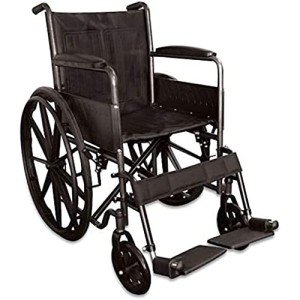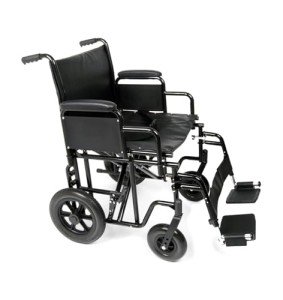Five Things You're Not Sure About About Bariatric Mobility Equipment

Donette
2025-03-03 15:26
4
0
본문
 What to Look For When Selecting Bariatric Mobility Equipment
What to Look For When Selecting Bariatric Mobility EquipmentBariatric mobility equipment assists healthcare facilities supply safe and dignified take care of obese clients. To make sure a favorable experience for both patient and staff, it's crucial to know what to try to find when selecting this equipment.
 Evaluation producer cleaning guidelines and sanitising recommendations. Consider a series of safety functions including reinforced frames and locking mechanisms.
Evaluation producer cleaning guidelines and sanitising recommendations. Consider a series of safety functions including reinforced frames and locking mechanisms.Size
Bariatric equipment is constructed with bigger platforms, increased weight capacities and greater physical measurements to assist individuals who weigh more than standard-sized users. This includes people with a Body Mass Index (BMI) of 30 or more. In addition to larger sizes, bariatric mobility aids offer cushioned seats and head assistance, enhanced stability and easier maneuverability to promote comfort and security for clients and caregivers.
While the requirement for specialized bariatric mobility equipment is increasing, lots of health care centers lack this necessary equipment. To avoid putting clients at risk, physician should carefully assess all choices readily available before selecting the finest bariatric mobility equipment for their facility.
Correctly picked and utilized, specialised dealing with equipment eliminates unneeded struggle that causes injuries throughout transfers, rearranging and moving. Manually lifting or moving a client significantly increases the danger of back, shoulder and wrist pressure, joint damage and fatigue that can trigger judgement lapses and accidents. This kind of handling likewise exposes staff to moral distress, especially when they are unable to assist clients safely and dignifiedly.
To decrease tension on caregivers, bariatric wheelchair 400 lb capacity mobility equipment is usually motorized to lower push/pull forces and facilitate manoeuvring over ranges. To make the most of security, therapists must have input into all equipment choices and use early in the buying procedure to make sure suitable sizing for clients in addition to to identify special requirements that need innovative gadget modification or center remodellings like expanded passages, entrances and ramps.
When looking for a bariatric wheelchair, scooter or bed, medical equipment distributors ought to provide details about the device's weight capacity, physical dimensions and building. This details is useful for comparing the features and advantages of each alternative. Making the effort to totally evaluate this kind of capital equipment can decrease the cost of acquisition, smart financing and yearly upkeep. This is specifically essential for bariatric mobility equipment that might be subject to more use and tear than standard-sized devices. This is why selecting the ideal gadget for each patient and setting is vital to decreasing direct costs in addition to indirect costs associated with poor outcomes.
Weight Capacity
Unlike basic medical equipment, bariatric travel wheelchair mobility aids are designed for patients who weigh 350 pounds or more and have a body mass index (BMI) greater than 30. Utilizing undersized or non-bariatric equipment with these patients can lead to discomfort, skin breakdown, bariatric Wheelchair injuries and falls-- not to mention additional personnel time and effort.
Safe dignified client handling is essential for all healthcare employees. Nevertheless, it can be challenging for personnel to handle overweight patients without the ideal equipment. This is particularly real for mobile patients with elevated needs that require assistance to move from bed, toilet or chair.
The right sized bariatric wheelchair and patient lifts enable people to maintain self-reliance with convenience, confidence and self-respect. It also enables nurses and other staff to focus on healthcare rather of manual moving maneuvers that can cause worker injury.
When choosing bariatric mobility aids, it is very important to seek advice from the product sizing guide and weight capacity rating before making a purchase. The sizing guide needs to be prominently displayed in the medical facility or center so that it is easy for patients and families to discover.
Devoted storage space ought to be offered for the safe and easy retrieval of equipment when it is not in usage. This will help to avoid overuse or abuse that could cause damage to the equipment and security risks for patients.
Other bariatric equipment includes slings and slide boards that connect safely to client lifts for transferring bigger clients with ease. These devices utilise momentum and low friction to guarantee smooth, steady transfers. They are also ideal for repositioning overweight patients in beds or chairs, assisting to avoid pressure ulcers.
Exam tables are another essential piece of bariatric mobility equipment for helping much heavier clients. Bariatric exam tables provide greater load capabilities and broader widths than standard models to enable much safer and more comfy positioning of overweight patients. Electric versions with powered height change likewise make it much easier for staff to access and deal with injuries. In addition, the large bariatric lift bases and longer booms on some equipment enable users to be moved quickly from wheelchairs and stretchers.
Safety
Bariatric client mobility equipment is larger, much heavier and more robust than basic medical devices. It might for that reason be harder to manoeuvre over cross countries or to transport throughout a facility. Nevertheless, with the ideal training and an extensive understanding of safe handling methods, staff can mobilise clients successfully without unneeded battle or risk to them or their care.
The most crucial security features of bariatric mobility aids include:
Utilizing the best sized equipment for transfers prevents straining staff or putting excessive pressure on joints and tissues. It also minimises injuries triggered by mismatched equipment and slings. Bariatric slings attach safely to raise equipment and cradle the body, making them appropriate for a large range of body shapes. They likewise feature cushioned edges to protect susceptible skin and strengthened building for toughness. Motorised floor raises incorporating force sensors permit caregivers to manage transfer motions to guarantee they stay within safe working load limits during complex manoeuvres. Powered adjustable width transfer surface areas streamline patient manoeuvring, particularly over thresholds and through doors. Virtual truth simulation systems enable safe handling practice and assessment of bariatric wheelchair 24 inch seat motion capabilities.
All bariatric mobility aids must be checked for damage, wear and tear before and after every use and saved securely when not in usage to prevent tripping dangers. They must be routinely cleaned up and sanitised to avoid infection. Staff must constantly follow producer sizing standards and weight limitations for bariatric mobility aids. Including therapists early in mobilisation preparation helps to identify correct equipment needs based on particular mobility and functional objectives.
Executing an extensive patient managing program that incorporates all of the above functions changes care experiences and enhances outcomes. This requires management concerns, budgeting, policies, training and culture building. Carefully examining the suitability of a gadget and choosing an authorised provider that offers the complete variety of options will assist to attain these objectives. Using an established professional in bespoke mobility options is a great way to attain this. They can supply a free assessment, trial rentals and assist to discover the finest service for your unique requirements.
Versatility
Selecting expert bariatric mobility equipment supports safe, dignified care for people with high body weights. It can reduce personnel fatigue and injury, and help attend to quality of life concerns caused by immobility. Nevertheless, successful implementation of these specialised aids depends on center top priorities, budgets, training and policies.
Bariatric chairs have larger seats and strengthened frames to accommodate a larger weight capacity compared to standard wheelchairs. Some likewise have reclining backrests and padded arms to supply convenience. Numerous have battery-powered alternatives for self-propulsion, decreasing transport and maneuvering efforts. Bariatric beds can manage people approximately 1000 lbs and have expanded surface areas that include more body size and weight. Some have power options to adjust bed height with the touch of a button, making it simpler for nurses and caregivers to perform injury care or administer medications without strain.
Similar to all medical equipment, bariatric mobility services ought to be completely evaluated before usage. Carefully assessing the fit, function and ergonomics of equipment helps staff feel great utilizing it. Training on appropriate handling principles and techniques-- consisting of sling option, fitting, maintenance and storage-- is very important to minimise pressure. Facilities should develop a bariatric handling committee to collaborate group efforts and assistance training and optimisation.
Tracking equipment usage and condition needs a clear strategy and process, especially for heavy items like bariatric wheelchairs, beds and hoists. Routine audits of equipment, cleansing and maintenance requirements must be carried out to identify any problems. Facilities must also examine policies and equipment options regularly, particularly when a new variation is offered that might enhance safety, stability or ease of use.
Bariatric mobility equipment is typically more pricey than basic health care equipment, however the upfront cost can be offset by reducing employee injuries, staffing needs and pricey problems arising from manual handling. By carefully examining the requirements of a center and client population, as well as choosing a knowledgeable partner to supply the very best equipment for the job, organisations can decrease costs in the long run. For instance, leasing bariatric equipment allows for flexibility to update designs when new innovations are launched, and prevents the expenditure of saving equipment that is not in use.

댓글목록0
댓글 포인트 안내